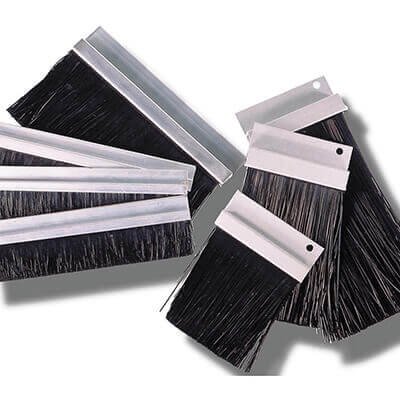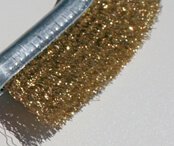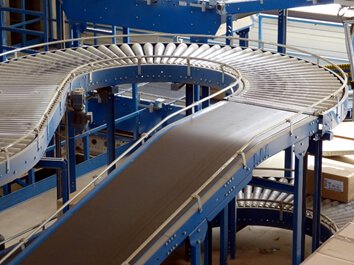
Strip brushes have many uses in industrial, commercial, and at-home settings. They are often used for sealing gaps and polishing items. They act as guides on conveyor belts, too. Strip brushes also restrict airflow for temperature control. How well they do any job is determined by the kind of strip brush you choose.
Read on to learn about the types, properties, and uses of strip brushes. You’ll find plenty of useful information to guide you in selecting the best strip brush for your needs.
What Is a Strip Brush?
A strip brush is a long, thin brush made up of thousands of bristles or filaments. These are clamped in the channel of a thin holder or backing. Some strip brushes have filaments mounted directly into the holder.
A strip brush goes by several names based on its design and uses. For instance, it is sometimes called a channel strip brush or a brush strip seal. Direct-mount strip brushes are sometimes called stapled-set strip brushes.
How to Choose the Right Strip Brush
There are several ways to classify strip brushes. Three of these are:
- Filament material
- Brush design
- Uses
Strip Brush Filaments
Strip brush filaments fall into three groups. These are synthetic, metal, and natural filaments.
The properties of each material is affected by the trim length and density. Shorter fibers, for instance, make a stiffer brush. More fibers make a denser brush. This increases how well it seals gaps and shields against airflow. It also makes the brush better at keeping out dust, bugs, etc.
Some filaments are thicker or thinner than others. They may also be straight or crimped. Furthermore, a single brush strip seal can have more than one type of filament.
Synthetic strip brush filaments

Synthetic filaments have the most uses. Many strip brushes are made with them. They also come in different colors.
Some synthetic filaments work well at high temperatures. Others withstand low temperatures and still work very well. Daoseal’s strip brush filaments are a good example. They can be used at minus 70 degrees Fahrenheit without cracking or deforming.
What’s more, most synthetic filaments do not absorb a lot of water. This helps them resist the growth of microorganisms.
Nylon
Nylon brush strip filaments resist wear. They also recover well from frequent bending. Plus, they do not react to many common chemicals. They are often used where alcohol, oils, dilute alkalis, and strong acids are present.
Polyester
Polyester strip brushes can be used in both wet and dry conditions. They have very good bend recovery, as well. They are like nylon in a lot of ways. Either type is used in some applications with the same level of performance.
Polypropylene
Polypropylene is a lot like polythene – a popular synthetic material. It is, however, harder and has greater heat resistance. Its filaments work very well in both wet and dry conditions.
Metal strip brush filaments

Metal filaments have superior hardness and wear resistance. They are a good choice when aggressive brush action is needed.
Image by Andreas Lischka from Pixabay
Steel
Steel filaments are tough with excellent wear and corrosion resistance. They work very well at very high temperatures. Steel strip brush filaments are usually either high-carbon steel or stainless steel.
Brass
Brass strip brush filaments will not scratch most metallic items. This is because brass is softer than most other metals. They also resist both wear and corrosion. They conduct electricity very well and reduce static, too.
Phosphor bronze
This is a copper and tin alloy that has small amounts of phosphorus. This gives it greater strength, stiffness, and toughness. It also gives it a finer grain. Filaments made of phosphor bronze are both harder and stiffer than those made of brass. It is also noted for its high corrosion resistance.
Natural strip brush filaments
Natural fibers tend to be the softest. This makes them useful for polishing delicate items. They are, however, less heat-resistant than other filaments. As a result, they work best at lower temperatures.
Horsehair
Horsehair strip brush filaments range from soft to medium stiffness. They are a good choice when you need an anti-static brush. They also work well for the application of adhesives. Horsehair filaments are unlikely to scratch most surfaces. This makes them ideal for dry polishing.
Tampico
Strip brushes made with Tampico plant fiber are medium soft. This makes them a good choice for use on wood. They perform well in both wet and dry conditions. Tampico filaments will not scratch most items. They are often used for gentle washing, dusting, and polishing.
Image by LoggaWiggler from ixabay

Strip Brush Design
The two important factors of strip brush design are the holder material and its shape.
Strip brush holder
The holder is made of either metal or synthetic (plastic) material. The metal ones are usually stainless steel or aluminum. Some companies specialize in the type of holder they use. For example, the strip brushes sold by Daoseal are in an aluminum holder.
Stainless steel brush strip holders are suitable for use at very high temperatures. They are also very corrosion resistant.
Aluminum brush strip holders come in both mill and anodized types. Anodized holders have greater durability and increased resistance to wear and corrosion.
Plastic brush strip holders tend to be flexible. Some bend around curved surfaces without having to be custom-made.
Strip brush shape
When we think of brush seals, it is the straight ones that first come to mind. There are, in fact, a lot of other types. The list is almost endless since strip brushes can be made for exact fit and purpose.
There are outside disk brushes with the filaments pointing outward. Inverted disk brushes have them pointing inward. Spiral brushes are used for getting into enclosed spaces. High-speed coil brushes and cup brushes are used for polishing and deburring.
There are cylindrical brushes, too. These are tightly coiled brushes mostly used for cleaning and polishing.
Uses of Industrial Brush Seals

Strip brushes have so many uses that it is impossible for one source to list them all. Here we will give you an idea of the many ways in which they are used in industrial settings.
What are brush strip seals used to do?
- Sealing around moving parts to reduce friction, wear, and tear.
- Closing gaps between stationary parts.
- Controlling airflow, vapors, and sprays.
- Maintaining temperature by stopping the movement of hot or cold air.
- Blocking out light and sound.
- Dissipating static.
- Sealing out vapors and sprays.
- Shielding paint booths.
- Guiding and sorting items on conveyor belts.
- Keeping out contaminants such as dust, rodents, and bugs.
- Removing dust, grime, and residue from items.
- Washing, deburring, and polishing items.
- Surface roughening.
- Applying coats of paint, adhesives, etc.
Brush strip seals act as effective weather seals, too. Daoseal strip seals, for instance, are designed to keep out rain, wind, and snow.
Where are brush strip seals used?
Strip brushes are used in warehouses and distribution centers. They also have many uses in manufacturing plants and assembly facilities. Commercial buildings also use them for sealing large gaps between doors. Good examples of this are airplane hangar doors and stable doors.
Brush seals are usually placed on moving equipment such as escalators and elevators. Of course, they are must-haves on conveyor edges. A lot of times brush strip seals are used as door bottom seals. They are also needed for many windows and raised access floors. You will see them on items of furniture, as well. For example, they are sometimes used on server rack cabinets.
Bottom Line: Does the Type of Strip Brush You Use Really Matter?
Yes, the type of strip brush makes a big difference in how well it works in certain situations. Strip brushes perform best when you keep their properties and design in mind. Choose the right one so you can avoid setbacks and lost resources. Go through the many options that are available to you. Ensure you buy strip brushes that match your specific applications.


